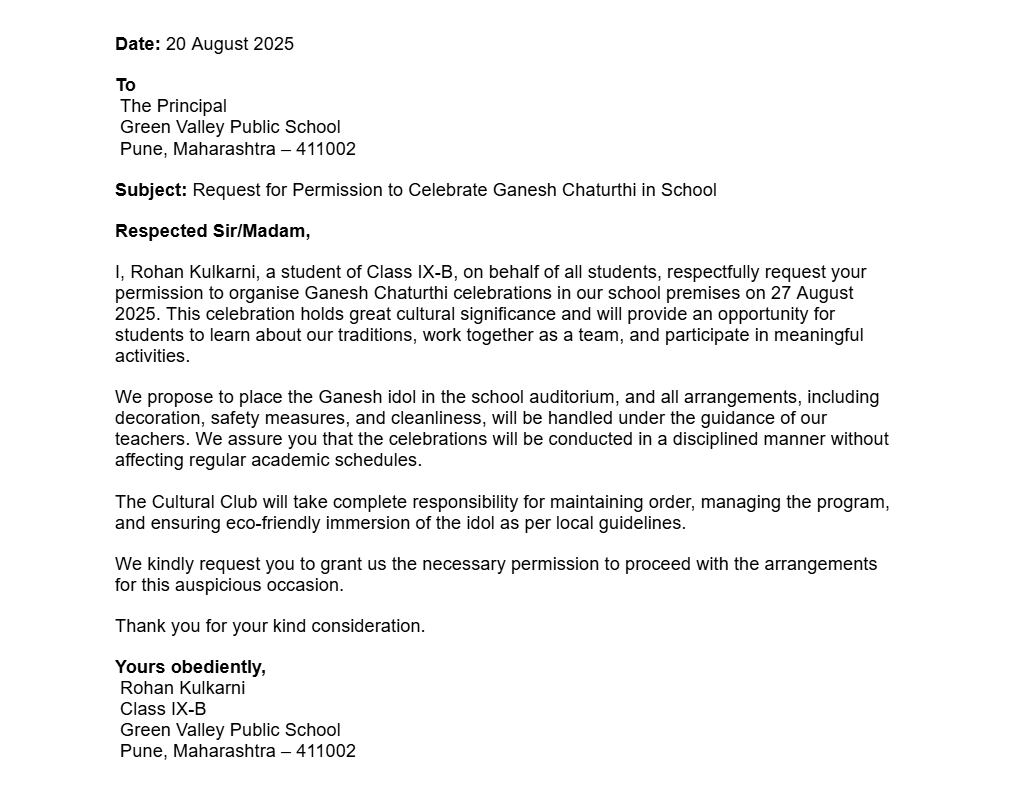Permission Letter Format
Applying for permission or leave is most often something people worry about. Every time you want to seek permission for something, you will have to write an application for permission to the higher authorities. A permission letter is basically a formal letter written to seek permission for any particular event or occurrence.
If you want to take leave or plan an event, you will have to get permission to take time off from school/work. Everything is documented, and so you will most often be asked to write a letter for permission. So, to get a clear understanding of the format, we have provided sample letters of request for permission.
Table of Contents
- What is a permission letter?
- How do I write a permission letter in English?
- Key Points for Writing a Permission Letter
- Request for Permission Letter Format Samples
- Frequently Asked Questions on Permission Letter
What is a permission letter?
A permission letter is a formal written request made by a student to the principal or school authority to seek approval for something specific related to academics. It is usually written when the student needs consent to be absent, participate in an external competition, attend a workshop or seminar, go on an educational trip, or request access to facilities or privileges within the school.
Unlike casual conversations, a permission letter follows a structured and polite tone, showing respect and responsibility as a student.
How do I write a permission letter in English?
The permission letter format in English is the standard structure for requesting formal approval from an authority. The key components ensure clarity and professionalism. Following the correct format improves your letter's impact in school, college, or office settings.
Writing a permission letter to your principal requires a formal tone and a clear structure. This kind of letter is often written by students to request leave, participate in an event, or seek special approval for academic reasons. Here's how the format works, with each part explained through short paragraphs and key points:
1. Sender’s Details (Top Left Corner):
Start your letter by mentioning your personal details—your full name, class and section, and roll number (if any). This allows the receiver to identify who the letter is from and verify the student’s credentials.
2. Date:
Leave a line after your details and write the date on which you’re writing the letter. Use the format "5 August 2025"—it keeps things formal and universally understood.
3. Receiver’s Details (Principal’s Address):
Next, mention the receiver's designation and the school's name and address. For example:
The Principal
Sunshine International School
Pune, Maharashtra
This part ensures the letter is officially directed to the right authority.
4. Subject Line:
Keep your subject line brief and to the point. It should clearly state what the letter is about. For example:
Subject: Request for Permission to Attend National Olympiad Training
This gives the reader a quick idea of the purpose before they dive into the full content.
5. Salutation:
Begin with a respectful greeting, such as:
Respected Sir/Respected Madam
Avoid informal greetings like “Hi” or “Hello,” since this is a formal letter.
6. Body of the Letter (Main Content):
This is the heart of your letter, and it should be written in 2–3 small paragraphs.
Paragraph 1: Introduction and Purpose
Introduce yourself and mention the purpose of writing. For example, “I am Priya Sharma, a student of Class 9A, and I would like to request permission to attend a science seminar held by the CBSE Board on 10 August 2025.”
Paragraph 2: Justification/Details
Explain why the permission is needed and how it supports your academics. Add supporting details such as dates, timings, locations, and who is organising the event. If you’re missing classes, mention how you’ll manage them (e.g., “I will make sure to complete all pending assignments and classwork after returning”).
Paragraph 3 (Optional): Polite Closure
End with a courteous line like: “I hope you will kindly grant me permission and support this academic opportunity.”
7. Complimentary Close:
Wrap up the letter with a formal closing such as:
Yours obediently,
Priya Sharma
Class 9A, Roll No. 17
This formal close leaves a positive impression and marks the end of your letter.
Key Points for Writing a Permission Letter
-
Use a formal, polite tone throughout the letter.
-
State your reason concisely without unnecessary details.
-
Always mention the date and correct designation of the recipient.
-
Do not use slang or informal phrases.
-
If handing the letter directly, the sender’s address may be omitted.
-
Check grammar, punctuation, and spelling carefully.
-
End with a polite closing, such as “Thank you for your consideration.”
-
Sign your name clearly under the closing.
Request for Permission Letter Format Samples
The format of an application for permission is just like that of any other formal letter. The only thing that would change would be the information you provide in the body of the letter. You should mention why and when you need permission. You can also state when you would be back. Go through the following sample letters for a clearer idea.
School Leave Permission Letter Format
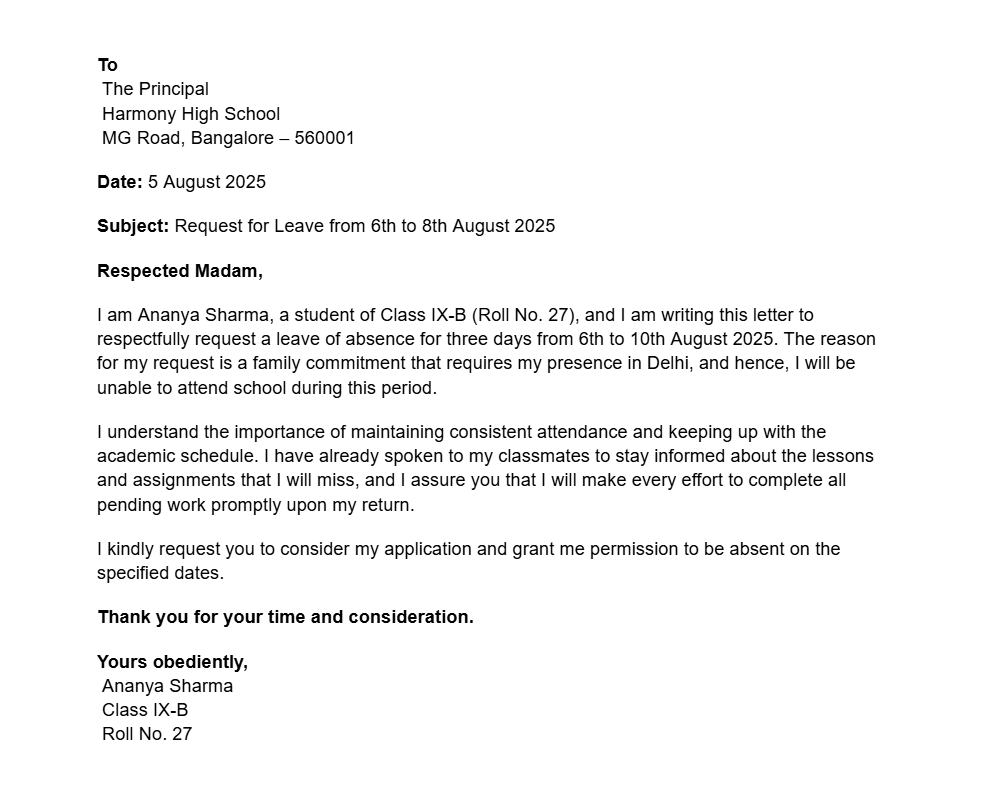
Permission Letter Format to the Principal from Parents
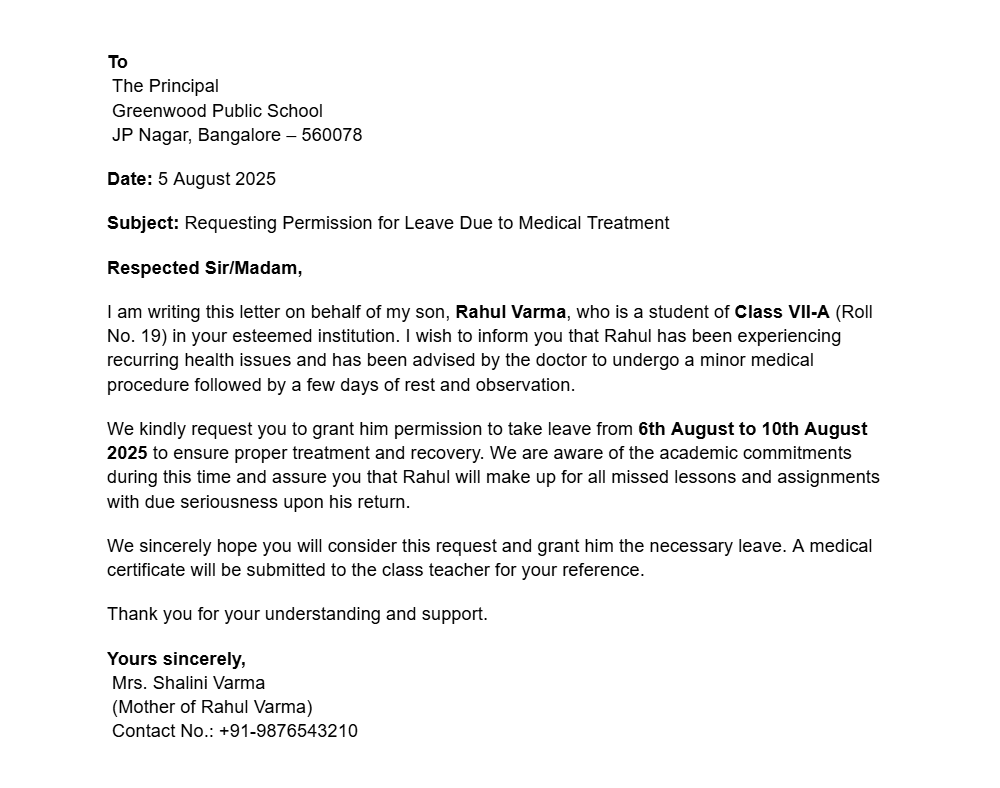
Letter to HOD for Permission to Practise for the Interdepartmental Competitions
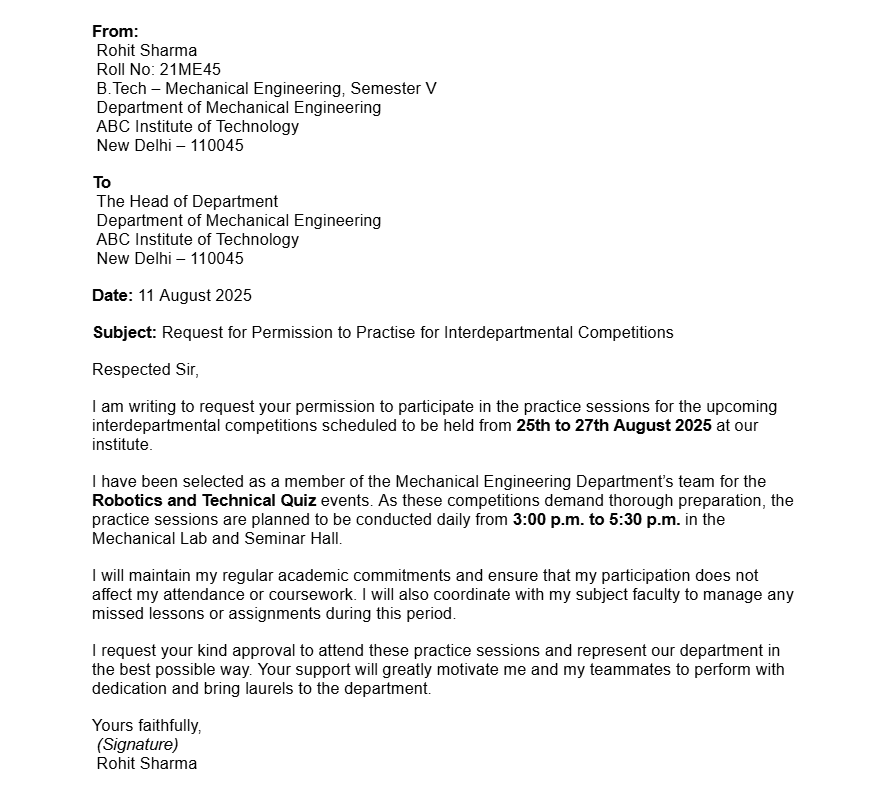
Borewell Permission Letter Format
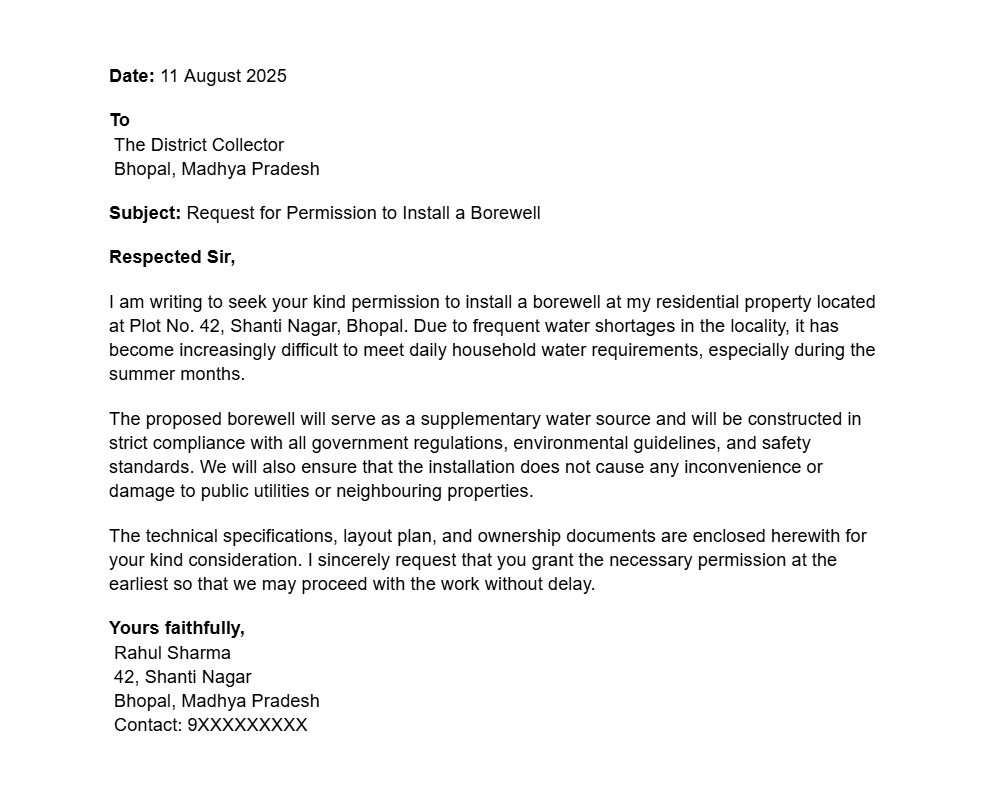
College Event Permission Letter Format
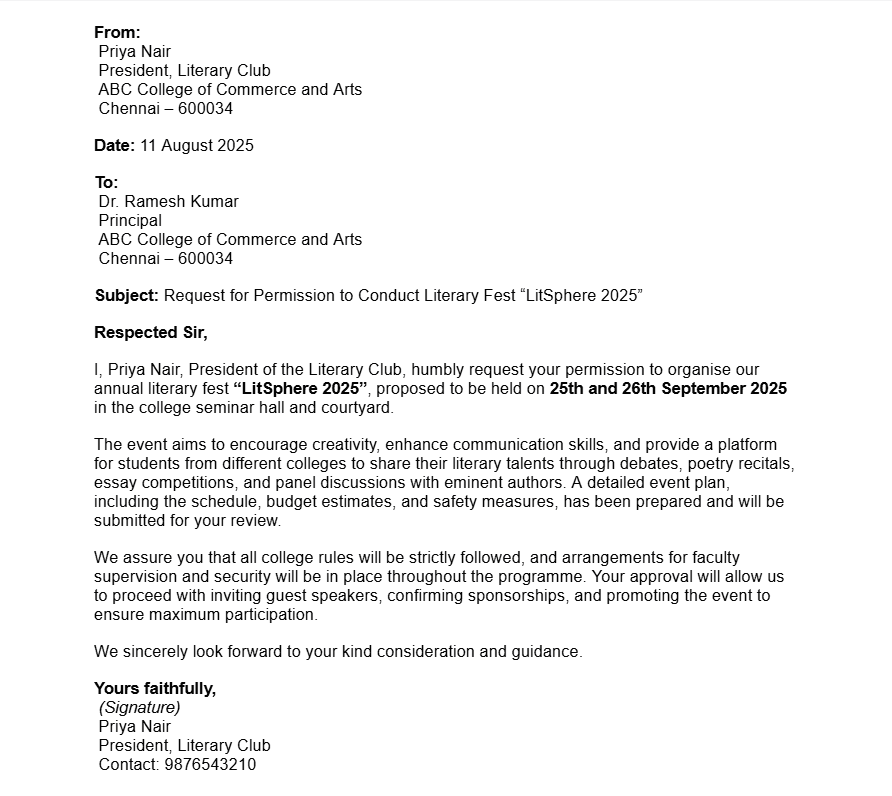
Permission Letter for Sports from Parents to the School
Ganesh Chaturthi Permission Letter Format
Sample Permission Letter from Parents to Go on a School Trip
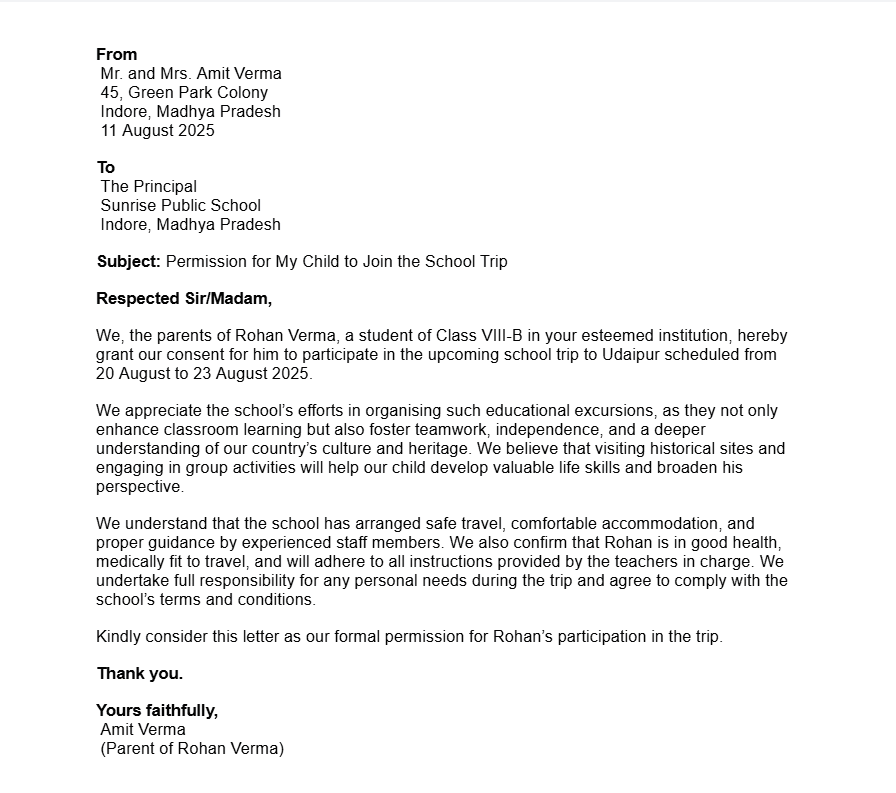
Office Leave Permission Letter Format
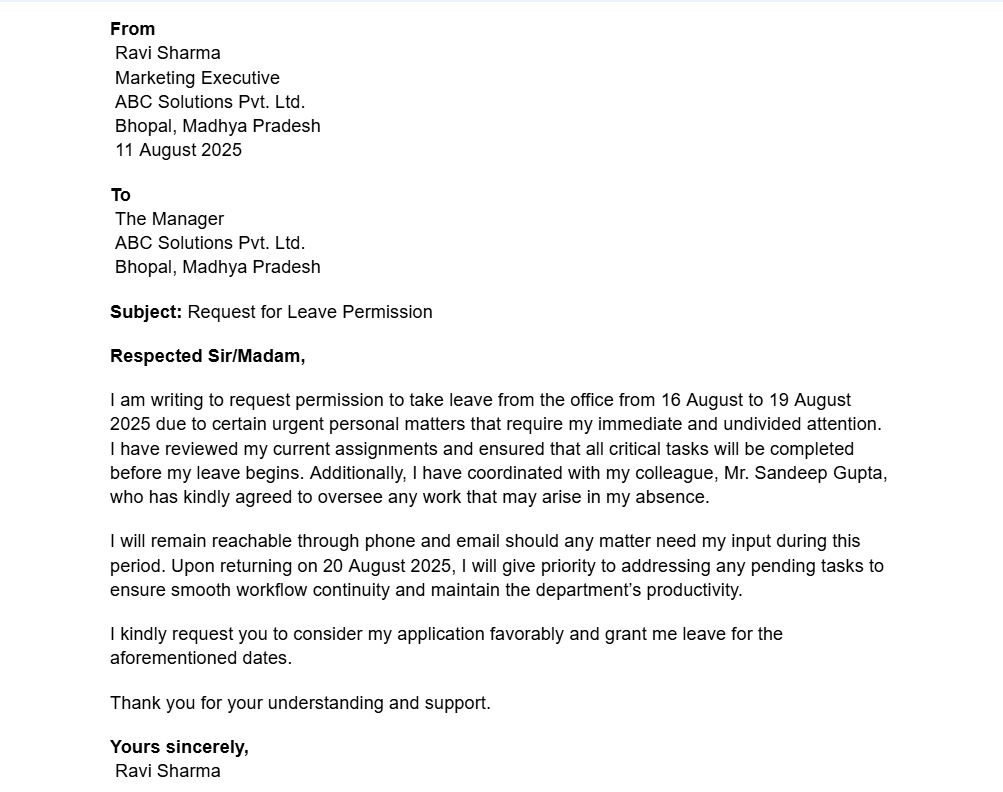
Wrapping Up
Writing a permission letter is an essential skill for students and professionals alike, as it reflects responsibility, respect, and clarity in communication. Whether it is for attending an event, taking leave, or seeking approval for any activity, following the correct format ensures your request is taken seriously. Always be polite, precise, and clear about your reason for seeking permission.
For more guidance and examples, you can also refer to our detailed guides on letter writing, leave letter, letter to the principal and so on, to improve your academic and formal correspondence skills.
Frequently Asked Questions on Permission Letter
Q1. How do I write a letter of permission for my teacher?
Answer: Dear [Teacher's Name], I am writing to request permission to take leave from school from [Starting Date] to [End Date]. This leave is required for [Reason for Leave], and I would appreciate your approval for this absence.
Q2. How do you write asking permission?
Answer: I am writing to ask your permission to use [give full citation of the work] for the purpose of [describe the intended use in sufficient detail]. Please complete and return this form to me at your earliest convenience. Thank you very much for your consideration.
Q3. What is the format of a permission paper?
Answer: The permission letter format typically includes your address, the recipient's address, date, subject, salutation, body (request and reasons), closing, and signature. Following a standard format ensures clarity and professionalism.
Q4. How to write a 1-hour permission letter?
Answer: To write a one-hour permission letter, start with a clear subject line, such as "Request for One Hour of Leave" or "Permission for Early Departure". Then, state the date and time you need the leave, explain the reason briefly, and express your understanding of the need to fulfill your responsibilities. Conclude by thanking the recipient for their consideration.
Learn More: Apology Letter Format: Best Samples and Expert Writing Guide
Admissions Open for
Admissions Open for
CBSE Schools In Popular Cities
- CBSE Schools in Bangalore
- CBSE Schools in Mumbai
- CBSE Schools in Pune
- CBSE Schools in Hyderabad
- CBSE Schools in Chennai
- CBSE Schools in Gurgaon
- CBSE Schools in Kolkata
- CBSE Schools in Indore
- CBSE Schools in Sonipat
- CBSE Schools in Delhi
- CBSE Schools in Rohtak
- CBSE Schools in Bhopal
- CBSE Schools in Aurangabad
- CBSE Schools in Jabalpur
- CBSE Schools in Jaipur
- CBSE Schools in Jodhpur
- CBSE Schools in Nagpur
- CBSE Schools in Ahmednagar
- CBSE School In Tumkur

